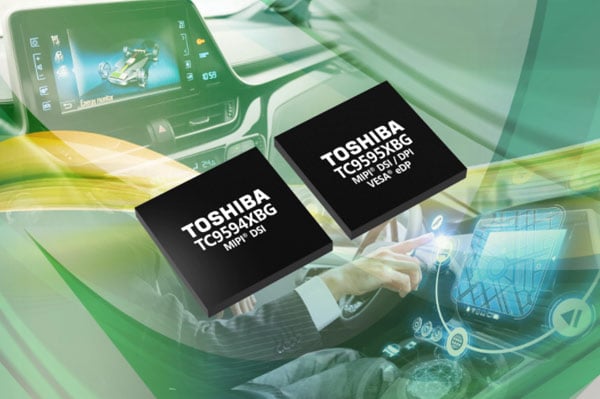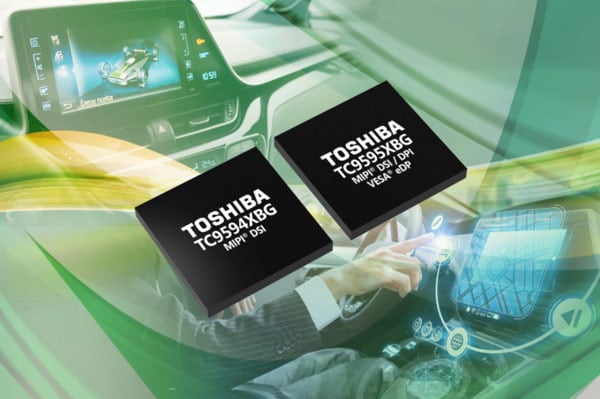Why The ICs Were Developed for Engineers
In-vehicle infotainment systems are increasingly in-demand, and this means engineers must meet the increasingly-stringent automotive standards that IVIs require, particularly when designing and developing such technology. Toshiba developed the TC9594XBG and TC9595XBG interface bridge integrated circuits because the manufacturer wanted to reduce the challenges that engineers encounter when dealing with automotive IVI systems.
Consider that the functionalities of IVI automotive systems—and therefore their design demands—prove increasingly challenging the more they lack support for different types of in-vehicle infotainment protocols.

Toshiba’s two interface bridge integrated circuits (pictured over a driver using an in-vehicle infotainment system): the TC9594XBG and the TC9595XBG. Image Credit: Toshiba.
Toshiba’s two bridge interface ICs (pictured above) are designed to support electrical engineers (and of course other design experts) who need to meet various compatibility requirements when developing and designing their IVI systems. As covered next, this is achieved thanks to the products’ support for multiple display types, which helps the interface bridge ICs to ‘bridge’ the gap between an IVI’s display and interface.
The Design Specifications and Benefits of Toshiba’s ICs
Toshiba’s TC9594XBG and TC9595XBG are both part of a 7-by-7 mm VFBGA—very thin profile fine-pitch ball grid array—80 package. Both ICs’ internal registers are accessed through either the SPI (serial peripheral interface) or the I2C bus.
At 166 megahertz (24 bit), the TC9594XBG supports parallel input and a four-lane, one channel output to Xilinx’s MIPI (Mobile Industry Processor Interface) DSI-TX.
The two inputs supported by the TC9595XBG, moreover, are four-lane one-channel MIPi DSI (Display Serial Interface) or MIPI DPI (Display Pixel Interface). As for its output, the TC9595XBG supports the Vesa DisplayPort 1.1a standard.
Fundamentally, as Toshiba’s product video explains, the two ICs have the “capability to connect multiple display interface types to host processors [and] bridge the display-interface gap to build your solution”. More information on the manufacturer’s display interface support is available on Toshiba.com’s Semiconductor section, as well as its automotive IC specifications table below.

A design specifications table on the audio-visual capabilities of Toshiba’s six in-vehicle infotainment-friendly integrated circuits (ICs): the TC9590 up to and including the TC9594 and TC9595 interface bridge ICs. Image Credit: Toshiba.
The Core Advantage of Toshiba’s ICs
Toshiba’s bridge integrated circuits, the TC9594XBG and the TC9595XBG, offer support to engineers by reducing the complexities that are prevalent when working with IVI systems. As touched on earlier, perhaps the biggest advantage of these interface bridge ICs is that both products support different types of display interfaces. The technology altogether offers enhanced functionality to in-vehicle infotainment systems—and ultimately can reduce the engineering demands of IVI design and development.





